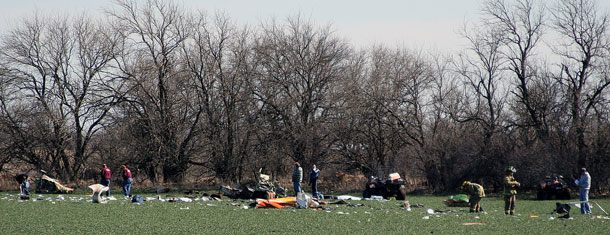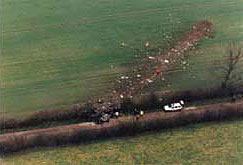
Worried about engine failure, or mechanical problems in the air? Forget it.
Richard Sanford is an air accident investigator who is finding it increasingly difficult to remain sanguine when he knows that the wrecks and the bodies he deals with are almost always the result of bad decision making, often on the ground before a flight even begins...
“Its ok I have a night rating”... how many times have I heard this statement from pilots when asked about the risks and suitability of their flight after dark ?' Why do pilot's adopt this mind set, which takes the risks of flying helicopters well beyond those posed when the big light above is switched on? Why are these pilots willing to place their loved ones or friends in such danger?
What if I said to these same individuals, "Here is a nice swimming pool. You, your family and friends are very welcome to use it day and night – however at night I may or may not put piranhas in the pool."Would they take the risk of a night swim? So why when we tell them that "Night flying plus bad weather can be deadly," do they insist on jumping into this particular pool?
The fatal accident rate during night flights is many times higher than during daylight hours. The same mind-set is evident when the pilot takes off during daylight hours in poor weather, or pushes on in poor weather.
My personal opinion is that we, as the industry, give them what they perceive to be a nice piece of shiny armour in the guise of five hours or so of instrument familiarisation training. And of course, most helicopters now have a GPS fitted.
The latter encourages them to fly from A to B without having to see very far, (you have to be able to see to navigate); and the former re enforces their decision to fly in this poor weather. If we teach a student an exercise, then test their skill level and tell them they have passed, is it not right that they should think that they are competent in that skill?
So we teach them instrument familiarisation and then test them on this discipline during a 'skills test',and if they achieve the required standard we give them a license. By doing so, have we not told them that they have proved to have sufficient skill to be able to fly the helicopter by sole reference to instruments as and when they might need to? So why then are we so surprised when that same pilot ends up in the mortuary?
The training is conducted with the instructor flying VFR and the student flying under 'the hood'. During the exercise the student will find this very difficult, but not to worry because 'Sir' is there to sort it out when it all goes wrong. 'Sir' even takes control while 'Bloggs' relaxes and reduces their stress levels However with some perseverance on both sides 'Bloggs' will achieve the required standard.
So where does it all go wrong ?
Orientation during night flights must be maintained by visual reference to ground objects illuminated solely by lights on the ground or adequate celestial illumination. Therein lies the problem. It is very difficult to see clouds, low hanging scud or fog, and even if the pilot does see them, it is almost impossible for the pilot to judge its distance and altitude.
When flying into an area of minimal ground lights (a black hole), the pilot is not able to judge just how difficult it's going to be until he (or she) is committed. The pilot is many times more likely to suffer from spatial disorientation when flying at night. Common factors in these types of accidents are dark night, poor weather and locations with few or no ground lights.
Spatial disorientation can be either the failure of the pilot to recognise the aircraft's motion and attitude and/or the failure to recognise their position in relation to the surface of the earth. This problem is frequently associated with VFR flights into poor visibility or IMC due to the factors mentioned above. Then, when the pilot's continued attempts to maintain visual contact with the ground fail, control is lost or maintained until they fly into terrain.
These types of accidents are usually fatal because they tend to be violent high-energy impacts compared with other types of accidents; therefore spatial disorientation accidents claim a disproportionate number of fatalities.
What about stress ?
Stress while flying stems from the man-machine interface. As individuals, we can all cope with varying levels of stress. Given the right amount for the right reasons stress is good for you – as long as it is not over a prolonged period of time. In fact a certain amount of stress can help sharpen our focus on the task at hand and is healthy.

- Spatial disorientation tends to result violent high-energy impacts
Stress for one person is not necessarily stress for another. The pilot who feels compelled to be on time for an appointment, or make the return flight, can be trained that the flight should be delayed or cancelled.
The mature pilot will know that the need to keep an appointment does not merit the risk of killing oneself. Stress can also be subjugated through experience and knowledge. As your piloting skills increase, you will be able to fly in increasingly difficult conditions. However, there is a point where even the most accomplished pilot can be affected by the stress of such flights and should decide not to go, or to alter his plan.
The pilot should always be aware that the real hazard is the modification of good judgment by stress, and therefore this should always remain a very real concern. It should be noted that accidents are also caused by lack of stress. I am sure you have all seen the signs "complacency kills".
An accident is the culmination of a series of events, each event reducing the pilot's flexibility or choice by some degree while increasing his stress level. Finally, there is one additional event, and the pilot by then has 'boxed himself in' which leaves him with no choices, and the accident occurs.
All of us have a stress level that, when exceeded, will tend to make the simple tasks we were formerly quite able to carry out difficult, if not impossible, to deal with.
A good example of this which you will all be familiar with is the point during your pilot training when we say "Okay, Bloggs, you can fly this thing around the circuit with or without me, so now I want you to navigate your way around the country, keeping your height, speed and direction, do all the radio work, know where you are at all times, and by the way I want you to time the legs and achieve those times!" What happened to your flying ability? Could you have coped with those tasks without the instructor?
No. Reason? You had run out of mental capacity. Your stress levels had exceeded this limit and the aircraft you were reasonably happy and competent in flying suddenly becomes very difficult to fly and refuses to settle down to a given speed or height, let alone point in the right direction. Simple tasks have now become very difficult.
As a pilot you need spare mental capacity to deal with the normal events encountered during the flight. It is when this spare mental capacity is exhausted that things become difficult. This of course drives the stress levels up even further, and very quickly decision making becomes impossible, and mistakes are made which can and often do become fatal mistakes.
Examples:
Simple benign indications in the cockpit have caused problems. We have had fluctuating air instruments (ASI, altimeter),
causing the pilot to over-react and throw the aircraft at the ground. We have had RPM indication faults which have resulted
in the pilot throwing the aircraft at the ground. In both cases the helicopter was destroyed and the pilot was lucky to survive.
Why did they do it? They thought that they had an engine problem or failure, and this decision was most probably arrived at by:
- Lack of knowledge of the aircraft and its systems.
- Lack of knowledge of the helicopter's behaviour when subjected to an engine problem.
These factors caused them to become so stressed that they were unable to recognise these problems as benign, and they over-reacted due to the lack of spare mental capacity. So let's go back to the pilot during his basic instrument familiarisation training. The exercise is briefed and flown as mentioned above. With perseverance he gets the hang of it, and although it's hard work due to the high levels of concentration, he is tested told that he can do it. Now, do we really think that when this pilot gets into inadvertent IMC at night or during the day, his stress level is going to be anywhere near the level that he experienced during training? Of course it's not: the environment is completely different.

- The mature pilot knows that the need to keep an appointment does not merit the risk of killing oneself
The situation will probably have been deteriorating for a period of time; at night, of course, the pilot may not even see the cloud until he is in it. During this time the pilot's stress levels will have been increasing. "Shall I, shan't I... do I turn back, or do I land?" The decision to push on is reinforced by training – that is, the instrument familiarisation training.
Now let's add 'the one other event' we talked about earlier: that is, in this situation it is not uncommon for the pilot to continue to try to look out to find external visual cues for a while, but when that fails the signals from the body's vestibular (balance organs in the ears) and proprioceptive (our body being acted upon by gravity) systems may be the only cues used to determine orientation and to make the control inputs.
Unfortunately these systems alone cannot provide reliable long-term orientation information and spatial disorientation may occur. The pilot must realise that he is designed to move around on the earth's surface, not above it, so our orientation systems (visual, vestibular and proprioceptive) work wonderfully when we are in contact with the earth, allowing us to maintain balance and orientation. Spatial orientation relies on the effective perception, interpretation and integration of visual, vestibular and proprioceptive sensory information – bloody difficult when you cannot see the ground. It should also be noted that few VFR helicopter pilots want to transition to instrument flying when in VMC. However, they have been trained for this event, have they not? So therefore they should be okay!
I wonder just how surprised they are when they realise they simply can not control the helicopter without reference to the ground? Now what did 'Sir' say? Oh yes! "Make a 180 degree turn out of the cloud." So the pilot takes this totally unstable aircraft from straight and level conditions and puts it into an even more unstable situation! Stability Flying a helicopter was once described to me like this: A fixed wing pilot moves the flight controls in order to make the airplane move in the direction the pilot wishes it to move. The helicopter pilot moves the flight controls in order to stop the helicopter moving in the direction it wishes to move.

- Lack of knowledge of the helicopter's behaviour when subjected to an engine problem can cause disaster
The helicopter has very high pitch and roll rates. The fact is that to fly successfully by sole reference to instruments, the pilot needs a great deal of training, not just five hours! Five hours will do one thing. It will lead you to think you can get away with it.
Talk to a pilot who flies a single-pilot IFR helicopter; he will tell you that it requires a considerable amount of currency – and remember, this is a helicopter being flown by an instrument-rated pilot, and it has an autopilot and is flown on that autopilot during IMC. So what makes you think that you can do it in your helicopter?
Do you have any of the following attitudes?
- Anti-Authority
- Impulsivity
- Feeling of invulnerability
- Macho approach
- Deference
Yes? Then you are at the top of my list. Your accident is a matter of "when", not "if", as your accident is not an 'if' but a 'when'. "The mark of a superior pilot is that he never puts himself into a situation that will require exceptional piloting skill to get out of." Lose sight of the ground lose your life. It's as simple as that.
